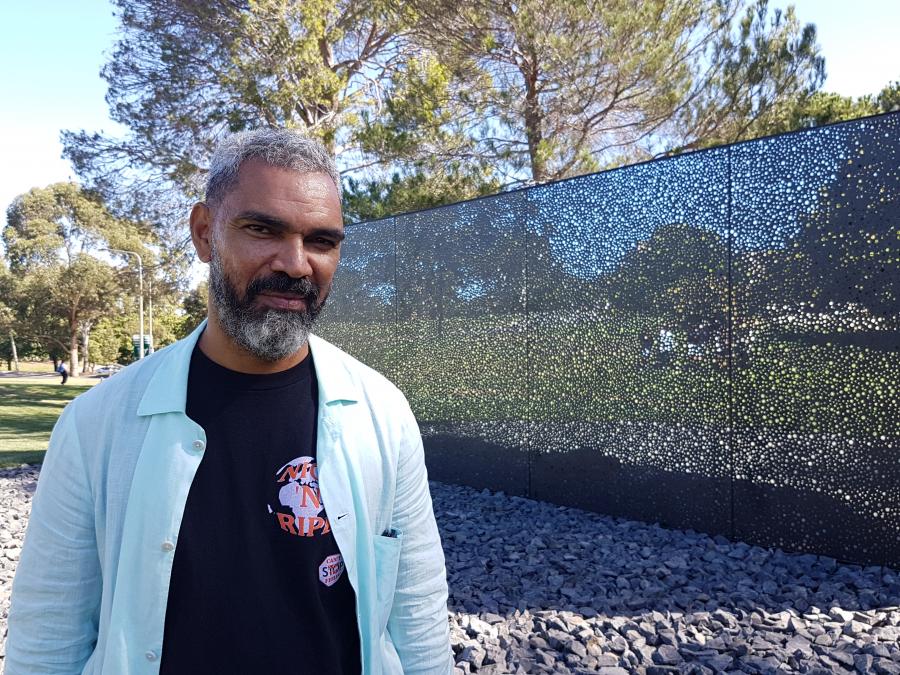For our Country

Daniel Boyd is passionate about his art and his culture. A proud Kudjala/Gangalu/Kuku Yalanji/Waka Waka/Gubbi Gubbi/Wangerriburra/Bandjalung man from North Queensland, Boyd was commissioned by the Australian War Memorial to create For our Country, a sculptural pavilion commemorating the military service and experience of Aboriginal and Torres Strait Islander peoples who have fought to protect their Country.
“It’s a huge honour to be given the opportunity to create a space that memorialises the Indigenous experience in the armed services and acknowledges the Aboriginal and Torres Strait Islander people and their relationship to the Memorial,” Boyd said.
“My great-uncle went to Egypt in the First World War … and it was amazing to have the opportunity to try to understand what his experiences were through art from the collection here at the Memorial.
“My father was in the navy, and my grandfather was in the army as well, so there is a family link, but I wanted to create an open space, an inclusive space, and that’s the point behind the pavilion … It’s about trying to create a place of significance to as many people as possible.”
Memorial Director Dr Brendan Nelson said Aboriginal and Torres Strait Islander peoples have had a long history of fighting for Country, dating back to before Federation.
“Within the spirit of equality is a special place accorded to Indigenous Australians. They have served in every conflict this country has engaged in. Despite laws that did not allow them to enlist, thousands volunteered to serve Australia,” Dr Nelson said.
“From a desperately unequal society they served, fought, suffered, and died for the young nation that had taken so much from them. Still today, Aboriginal and Torres Strait Islander men and women continue to do so with pride and professionalism, which is nothing short of inspiring. This sculpture honours their service.”
Created in collaboration with Edition Office architects, For our Country includes a ceremonial fire pit within a circular stone field and features a two-way mirrored glass façade covered in thousands of transparent circular dots or lenses that reflect the viewer and the Memorial across its surface. Behind the glass wall is an intimate, contemplative space with a curved black wall and seating constructed of black pigmented rammed earth.
Boyd describes the work as a manifestation of a deep connection that Aboriginal and Torres Strait Islander people have to the land, and their responsibility to future generations.
“It’s about how they will inherit this relationship, and the generational exchange of knowledge that has happened hundreds of thousands of times: from parent to child, grandparent to child, great-grandparent to child, and so on,” he said.
“It is about our respect for the land, and how we would like our children to experience that connection, while understanding the sacrifices made to seek a system in equilibrium.
“I wanted to try and create a space that was as inclusive as possible; somewhere that people could engage with the experience of Aboriginal and Torres Strait Islander people and their relationship to the Memorial.
“It’s about perception, and about how we see, or how we understand, our relationship to time and space.
“The thousands of clear lenses represent our perception, highlighting our incomplete understanding of time, history and memory …
“Each lens represents an individual understanding of something, and effectively the field of lenses is about multiplicity or plurality and how we collectively understand …
“The intent of it was to create a space for reflection and contemplation so that people can try to understand the experience of Aboriginal and Torres Strait Islander people.”
The work was selected from a shortlist of submissions and approved by a group of national Indigenous military personnel, curators, and local Elders. It contains soil from Aboriginal and Torres Strait Islander nations across Australia, and communities are invited to make deposits of soil during Reconciliation Week and NAIDOC Week celebrations by submitting a request form, or by emailing forourcountry@awm.gov.au
“There are many different Aboriginal and Torres Strait islander nations in Australia, and they all have a different understanding of their different experiences,” Boyd said.
“It’s about having a space that they can all have access to … so I wanted to create a pavilion where you can have a direct relationship with it.
“Each nation is unified in this place, where a piece of real Country joins the many lands our ancestors have defended … to serve Australia.”
For our Country will be dedicated by Dr Jackie Huggins, Mr Kerry Stokes, Dr Brendan Nelson, Squadron Leader Gary Oakley, and the United Ngunnawal Elders Council at 9am on 28 March 2019.
Join artist Daniel Boyd and architects Aaron Roberts and Kim Bridgland in the Memorial sculpture garden at noon for For our Country: in conversation. For more details about the talk, visit here. For more information about the work, visit here.